A product market fit analysis helps businesses and startups understand how well their product aligns with the target market. It allows thorough examination, efficient resource allocation, and development strategies crucial for resonating with and gaining traction within the intended audience. Product market fit is the cornerstone of sustainable growth and success in today's competitive landscape.
Aloa, an expert in software outsourcing, emphasizes the importance of solid product market fit analysis, particularly for entrepreneurs seeking to establish a strong foothold in competitive markets. Drawing from our extensive experience with diverse products and markets, we recognize the transformative impact a well-executed product-market fit analysis can have on a business's trajectory.
In this blog, we'll explore the concept of product market fit analysis and its significance. We’ll also discuss how to conduct one, its different types, and how it helps understand customer needs, refine product offerings, and optimize market strategies. Understanding this concept is essential for sustainable success in competitive markets.
Afterward, you'll learn how to leverage product market fit analysis in your business operations effectively. With practical methodologies and actionable insights, you'll confidently navigate the intricacies of this analysis, identifying opportunities for growth and innovation in your product offerings.
Let’s get started!
What is a Product Market Fit Analysis?
A product market fit analysis involves assessing whether a product addresses the specific needs of its target market. Data through surveys, interviews, and customer feedback are the primary methods for this analysis. Evaluation of key metrics, including customer acquisition, retention, and satisfaction, is central to determining product market fit.
Understanding and achieving product market fit is crucial for startups as it allows them to gauge market demand and relevance to their target audience. Recognizing that achieving product market fit requires continuous assessment and adaptation is essential. This analysis is pivotal in ensuring startups effectively align their products with market demands.
How To Conduct a Product Market Fit Analysis
Achieving product market fit is crucial for the success of wearable health devices. It ensures that the product meets the needs and expectations of its target users while addressing market demands effectively. Here's how to conduct a thorough product market fit analysis for effective research, customer validation, and iterative development:
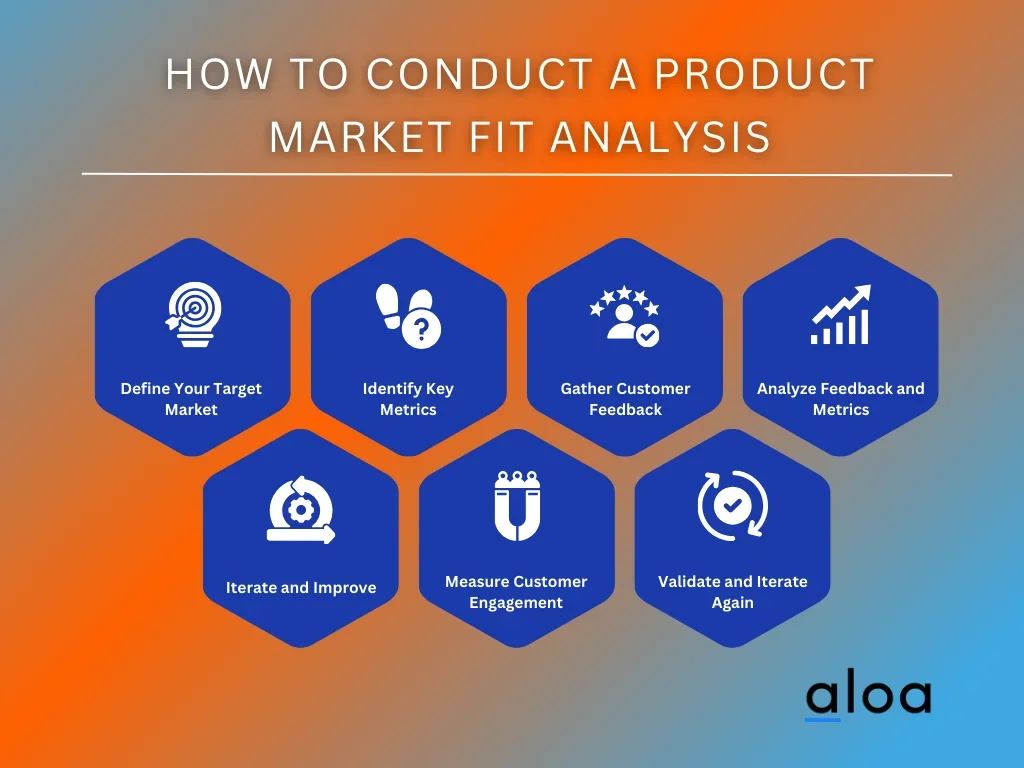
Step 1: Define Your Target Market
In the initial stage of developing your business strategy, it's crucial to identify the ideal customer for your product or service. This necessitates determining your target market's demographic, psychographic, and behavioral characteristics, so you can tailor your offerings to meet their specific needs.
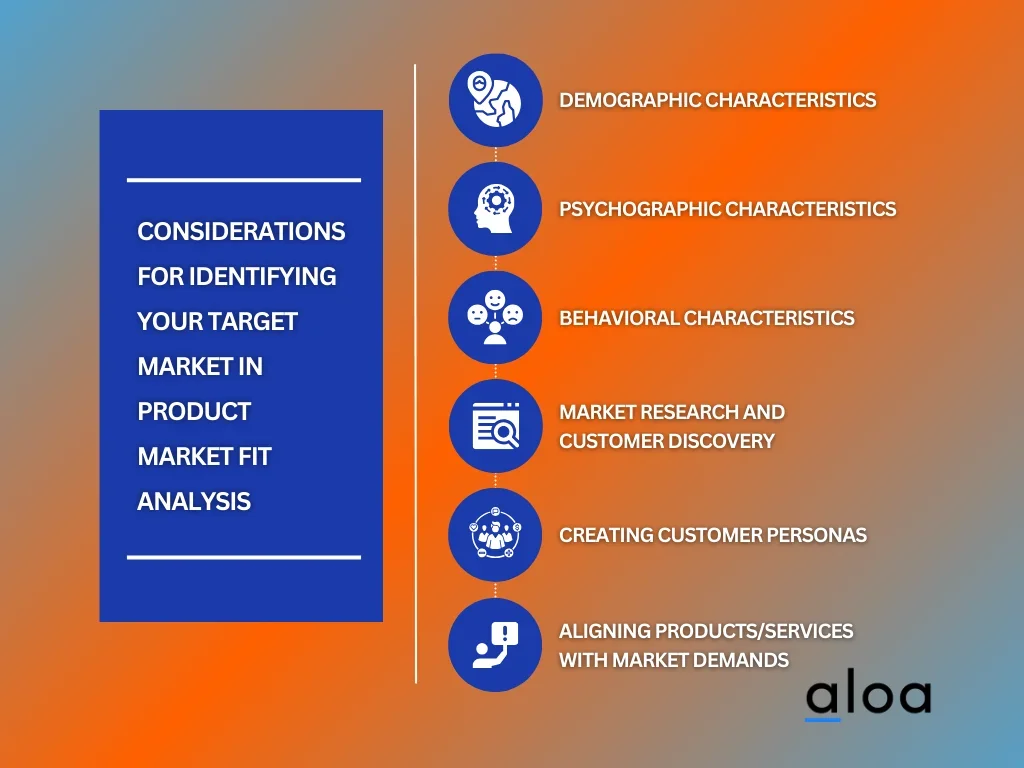
Conducting thorough market research and customer discovery will help validate your assumptions about your target market. This approach allows you to use data to create a customer persona that accurately represents your audience. Here are some essential factors to consider as you dive into this process:
- Demographic Characteristics: These include age, gender, income level, education level, occupation, marital status, and location. Understanding these demographics helps you pinpoint your potential customers and their location.
- Psychographic Characteristics: This involves understanding the lifestyle, interests, values, attitudes, and beliefs of your target audience.
- Behavioral Characteristics: This refers to the buying behavior, usage patterns, brand loyalty, and decision-making processes of your target market.
- Market Research and Customer Discovery: Conducting thorough market research and customer discovery helps validate your assumptions about your target market. This involves gathering data, conducting surveys and interviews, and analyzing industry trends to gain insights into customer needs, preferences, and pain points.
- Creating Customer Personas: Using data from market research and customer discovery, you can craft customer personas representing your target audience. These personas embody your ideal customers' traits, behaviors, and preferences, enhancing your understanding and connection with your target market.
- Aligning Products/Services with Market Demands: Understanding your target market allows you to customize your products or services to match their needs and preferences, ensuring alignment with changing market demands and consumer preferences, ultimately enhancing customer satisfaction and loyalty.
Step 2: Identify Key Metrics
After defining your target market, it’s time to determine the key metrics to help you measure product market fit. These metrics could include customer satisfaction scores, retention rates, conversion rates, and Net Promoter Score (NPS).
Moreover, identifying the right metrics is crucial for measuring a product's success in the market. These metrics should be specific, measurable, and directly relevant to the product and target market. Here are some key metrics you should consider in conducting a product market fit analysis.
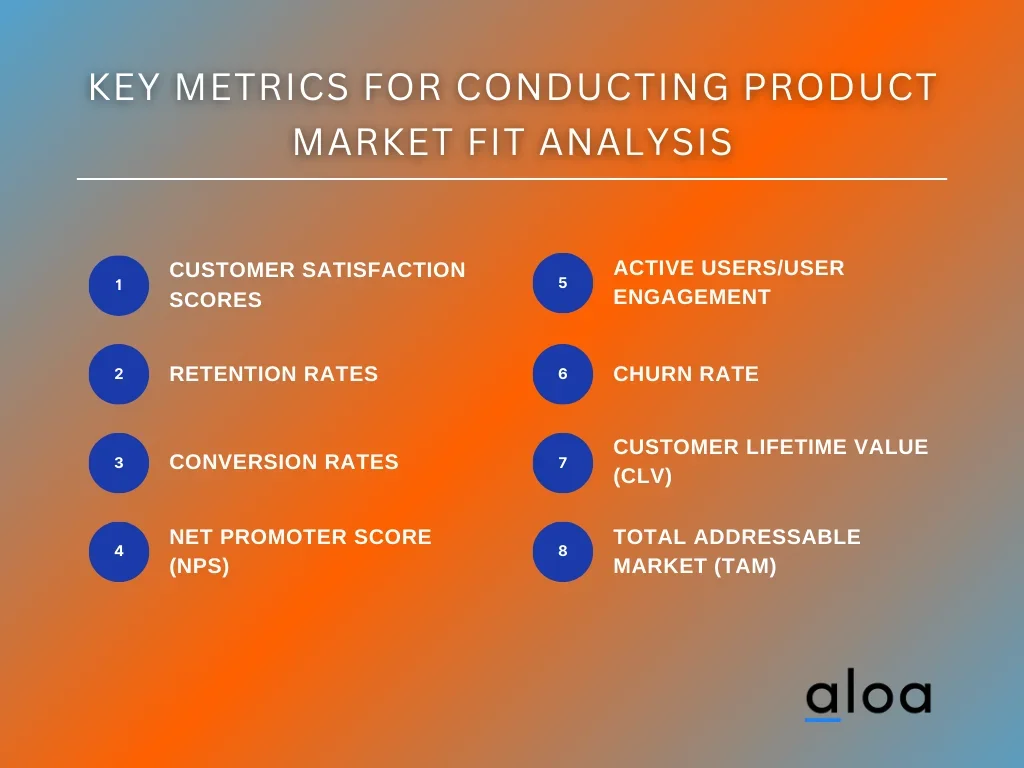
- Customer Satisfaction Scores: Measure customers' satisfaction with your product or service. It could be assessed through surveys, feedback forms, or direct customer interactions.
- Retention Rates: Indicate the percentage of customers who continue to use your product over a certain period. High retention rates suggest that customers find value in your product and are likely to continue using it.
- Conversion Rates: Track the percentage of users who take a desired action, such as purchasing, signing up for a trial, or subscribing to a service. Monitoring conversion rates helps assess the effectiveness of your marketing and sales efforts.
- Net Promoter Score (NPS): Measures customer loyalty and satisfaction by asking customers how likely they are to recommend your product or service to others. It provides insights into customer advocacy and can help gauge overall customer sentiment.
- Active Users/User Engagement: Indicates how frequently and how deeply users interact with your product. This can include metrics such as daily or monthly active users, time spent on the platform, and frequency of interactions.
- Churn Rate: Measures the percentage of customers who stop using your product within a given period. High churn rates may indicate issues with product satisfaction or retention strategies.
- Customer Lifetime Value (CLV): Estimates the total value a customer brings to your business over their lifetime as a customer. It helps determine the profitability of acquiring and retaining customers.
- Total Addressable Market (TAM): Represents the total revenue opportunity available for your product or service. It enables you to estimate the revenue potential of your product within the target market and determine if your product has enough customers or market fit to achieve sustainable growth.
Step 3: Gather Customer Feedback
Once you’re done identifying the key metrics, it’s time to collect feedback from your target market through surveys, interviews, usability tests, and social media monitoring. Focus on understanding how customers perceive your product, what features they find most valuable, and areas for improvement.
Furthermore, collecting customer feedback is crucial for assessing whether your product meets their requirements. You can manage this valuable information from surveys, interviews, or focus groups. Incorporating these open-ended questions can yield insightful details about customer experiences and pain points:
- Experience: Can you describe your experience using our product/service?
- Value: What aspects of our product/service do you find most valuable, and why?
- Expectations: How does our product/service meet or fall short of your expectations?
- Improvements: What improvements would you suggest to enhance your experience with our product/service?
- Challenges: Can you share any challenges or difficulties you encountered while using our product/service?
- Ease of Use: In what ways does our product/service make your life/job easier or more difficult?
- Value Proposition: How would you describe the overall value proposition of our product/service?
Step 4: Analyze Feedback and Metrics
Analyze the feedback and metrics gathered to identify patterns, trends, and insights. Collecting user feedback helps gauge satisfaction and identify areas for improvement. Subsequently, businesses can evaluate their market fit by analyzing customer acquisition cost, retention rate, and average revenue per user.
Additionally, using the Net Promoter Score (NPS) to measure user loyalty provides insights for enhancing the product. You can utilize surveys, focus groups, and social media to gather more detailed feedback from the target audience. Furthermore, regular reviews and updates ensure that the product meets customers' evolving needs continuously. Lastly, encourage your product development teams to use enterprise feedback management software to centralize feedback and align teams efficiently.
Step 5: Iterate and Improve
Based on the insights gained, refine your product to address customer needs and pain points effectively. Implement necessary changes to features, user experience, pricing, or messaging, then continuously test new features or alterations to stay ahead in this competitive landscape.
Revisiting and updating your product market fit analysis also ensures sustained success. Maintain a close watch on metrics such as customer retention and engagement to gauge progress. Once you do, look for recurring areas where your product falls short of user expectations, and only then can you make some improvements.
Step 6: Measure Customer Engagement
To assess the level of interaction with your product, monitoring customer engagement and usage patterns is vital in the process. Start by tracking metrics such as retention rate, customer satisfaction, and referrals using the best referral program software to provide valuable insights into customer involvement. Once you have the data, adjust as necessary and ensure that your product offers enough value to maintain high levels of customer engagement.
Furthermore, leveraging customer satisfaction surveys reveals strengths and areas for improvement in the product. Consider getting customer referrals to demonstrate satisfied customers' willingness to recommend the product, indicating a strong fit within the market. By understanding and measuring customer engagement, it results in optimal product market fit.
Step 7: Validate and Iterate Again
Lastly, continuously validate your product market fit through ongoing metrics and customer feedback analysis. Keep iterating and improving your product to align with market needs and preferences. It's important to remember that achieving product market fit is an ongoing process that demands constant attention.
Additionally, guided by customer feedback and market validation, this iterative approach ensures the product evolves in the right direction, aligning seamlessly with the ever-changing needs and expectations of the target market. Regularly reassess and adjust your strategies based on these insights to maintain relevance and competitiveness in the market landscape.
Different Types of Product Market Fit Analysis
Analyzing product market fit is essential for startups, businesses, and product developers to ascertain alignment between their offerings and target markets. It ensures that resources are effectively allocated and that products meet customers' needs in a competitive landscape. Let's explore various product market fit analysis methods.
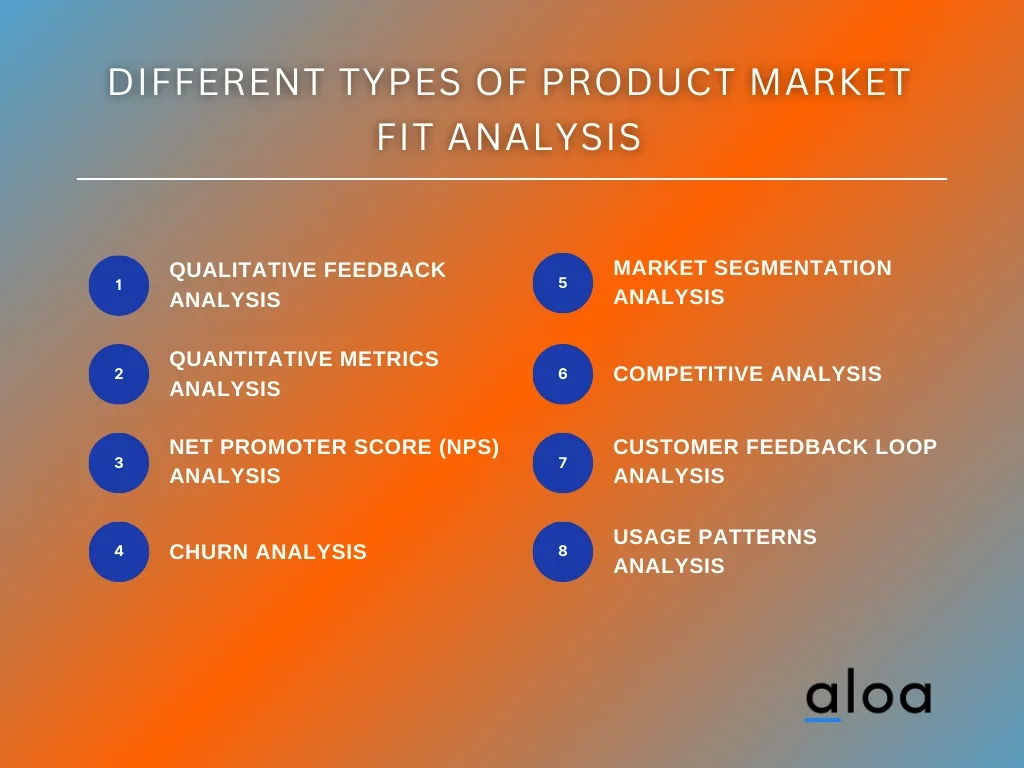
Qualitative Feedback Analysis
Customer feedback through surveys, interviews, and focus groups is crucial for product management. Qualitative feedback analysis helps businesses understand customer needs, preferences, and the right product features. This analysis also uncovers new product growth and expansion areas, further strengthening the business model.
Quantitative Metrics Analysis,
Quantitative metrics analysis is vital in assessing customer satisfaction and engagement. Businesses can measure customer acquisition cost, churn rate, and lifetime value by analyzing data to gain market insights. Surveys and user behavior analysis provide valuable data to identify patterns and guide product improvements.
Net Promoter Score (NPS) Analysis
NPS analysis measures customer loyalty and satisfaction using a simple survey. Customers rate their likelihood to recommend the product on a scale of 0-10, categorizing them as detractors, passives, or promoters. The NPS is derived from the percentage of promoters minus the percentage of detractors and provides insights into customer perceptions.
Churn Analysis
Churn analysis helps businesses understand why customers stop using their products or services. It provides insights for improvement and customer retention. Factors like poor user experience and lack of perceived value contribute to churn. Calculating churn rate involves dividing lost customers by the total customer count to measure customer attrition.
Market Segmentation Analysis
Market segmentation analysis is crucial for effective product management. Businesses can identify target groups with shared preferences through dividing the market by demographics, geography, psychographics, and behaviors. This helps develop products and marketing strategies, leading to a higher likelihood of product market fit.
Competitive Analysis
Startups must analyze competitors' products, pricing strategies, and marketing tactics to understand their market position. This ongoing process helps identify gaps in the market and differentiate themselves. Employing tools like SWOT analysis facilitates comprehensive competitive analysis.
Customer Feedback Loop Analysis
Startups must conduct customer feedback loop analysis to enhance their product. This involves collecting and analyzing feedback, identifying trends, and implementing changes. Having that said, understanding customer preferences and needs, startups can improve their product. Feedback loop analysis can be done through surveys, social media, and customer support.
Usage Patterns Analysis
Product management involves understanding customer interactions and analyzing usage patterns. Data is gathered through surveys, user behavior tracking, and testing. These insights inform product development and marketing strategies. Regular review and updates are necessary for ongoing success.
Benefits Of Product Market Fit Analysis For Business/Startups
A product market fit analysis is instrumental in guiding the success trajectory of startups in today's competitive landscape. Its significance lies in its ability to pinpoint the alignment between a product and its target market, paving the way for sustainable growth and customer satisfaction. Here’s how it plays a vital role in steering your business toward success:
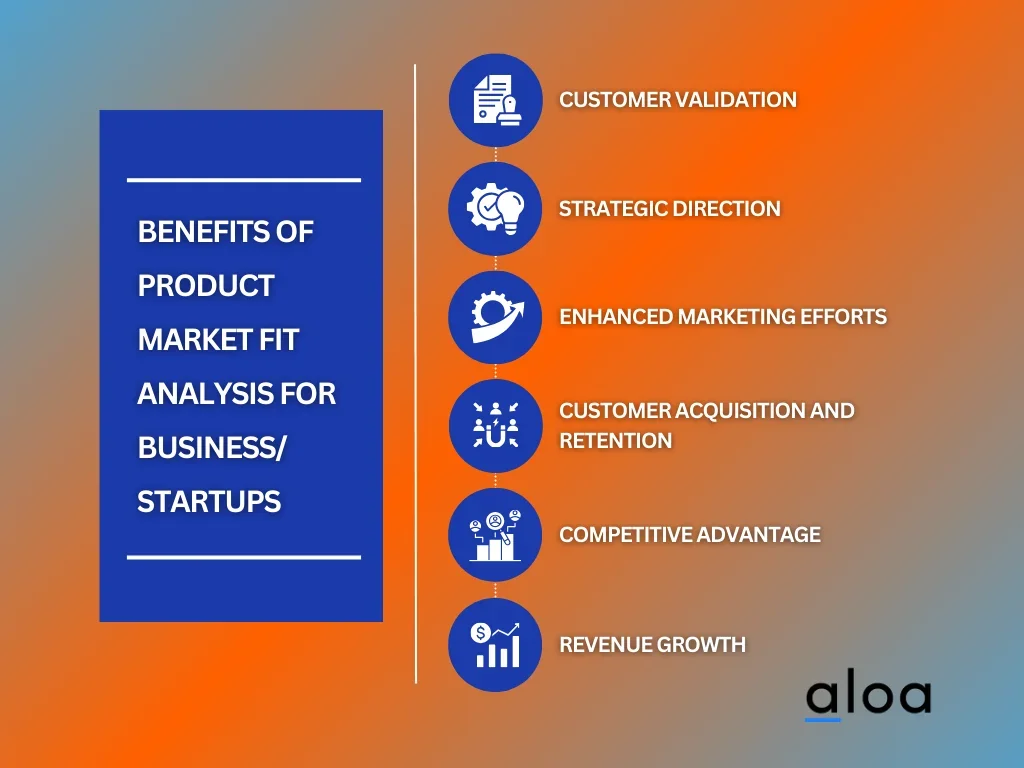
Customer Validation
Customer validation is an essential process to ensure that your product aligns with the needs and desires of your target audience. You can gain valuable insights into their pain points by validating your product with real customers, preferences, and expectations. Doing so enables you to make necessary adjustments for a better fit.
The feedback gathered during validation shapes your marketing strategy, effectively conveying your product's value to potential customers. A successful customer validation process leads to higher satisfaction and retention rates and fosters positive referrals, further solidifying your product market fit.
Strategic Direction
In navigating strategic direction, product management analysis plays a vital role in understanding the needs and expectations of the target audience. Tailoring products and services to cater to customer demands minimizes the risk of launching offerings that do not resonate with the market.
Furthermore, successful product market fit enhances customer retention, loyalty, and revenue growth. Employ natural language processing (NLP) techniques and leverage external factors to ensure that your strategic direction aligns with customer needs and preferences, ultimately leading to sustainable development and success in the market.
Enhanced Marketing Efforts
Enhanced marketing efforts stem from accurately identifying the target audience and tailoring strategies to meet their needs. Product management can be crucial in enabling businesses to understand customer needs and refine marketing approaches for specific demographics.
Additionally, by aligning marketing strategies with customer expectations, businesses can achieve higher customer engagement and improved ROI. Product market fit analysis helps avoid resource wastage on ineffective marketing strategies, creating a competitive advantage for businesses.
Customer Acquisition and Retention
Improving customer retention can yield higher revenue and foster long-term business success. To achieve this, take the time to grasp customer needs and ensure your products and services align with their needs and preferences, facilitating customer acquisition and retention.
Notably, conducting product market fit analysis empowers businesses to pinpoint areas for enhancement in their offerings, ensuring enhanced customer retention. Such analysis enables businesses to customize their products and services to fulfill customer demands, increasing customer acquisition and retention rates.
Competitive Advantage
A robust product market fit analysis allows businesses to pinpoint their distinct selling proposition and gain a competitive edge by grasping market dynamics and customer needs. Businesses can tailor their offerings to outperform rivals, identifying improvement areas and optimizing products to provide insights into customer preferences.
Furthermore, practical analysis can attract and retain customers, ensuring long-term success. Competitive advantage is vital for businesses to flourish in dynamic markets, enabling them to thrive amid competition. Ultimately, product market fit analysis is instrumental in creating a competitive advantage, helping companies stand out.
Revenue Growth
Understanding customer needs and preferences allows businesses to develop products that resonate with them, leading to increased revenue growth. Additionally, identifying the right target audience through product market fit analysis can increase customer loyalty and retention rates, contributing to sustained revenue growth.
Moreover, a comprehensive understanding of the market allows businesses to identify new opportunities for growth and expansion, further contributing to revenue growth. Investing in a product market fit analysis gives firms a competitive advantage, positioning them for long-term revenue growth and success.
Key Takeaway
A product market fit analysis is essential in understanding the dynamics of any industry, particularly when it comes to offering products and services that resonate with customers' needs and preferences. It involves a deep examination of how well a product or service satisfies the demands of a specific market segment. Even more, it dives into understanding customer pain points, preferences, and behaviors to tailor offerings that address these aspects effectively.
With the ability to empower startups and businesses to spot market opportunities, fine-tune value propositions, and boost customer satisfaction, learning the nuances of product market fit analysis is imperative. Coupled with this learning curve is the necessity to consistently refine and adjust your products in response to market feedback, allowing you to remain competitive and stay up to date with the evolving marketplace trends.
To ensure your venture thrives, subscribe to our email list via the Aloa blog page for exclusive insights into analyzing product market fit and stay updated on the latest trends in the startup ecosystem. For inquiries or assistance with your analysis, contact us at [email protected]. Embrace robust strategies for achieving product market fit to propel your organization toward unparalleled success.

